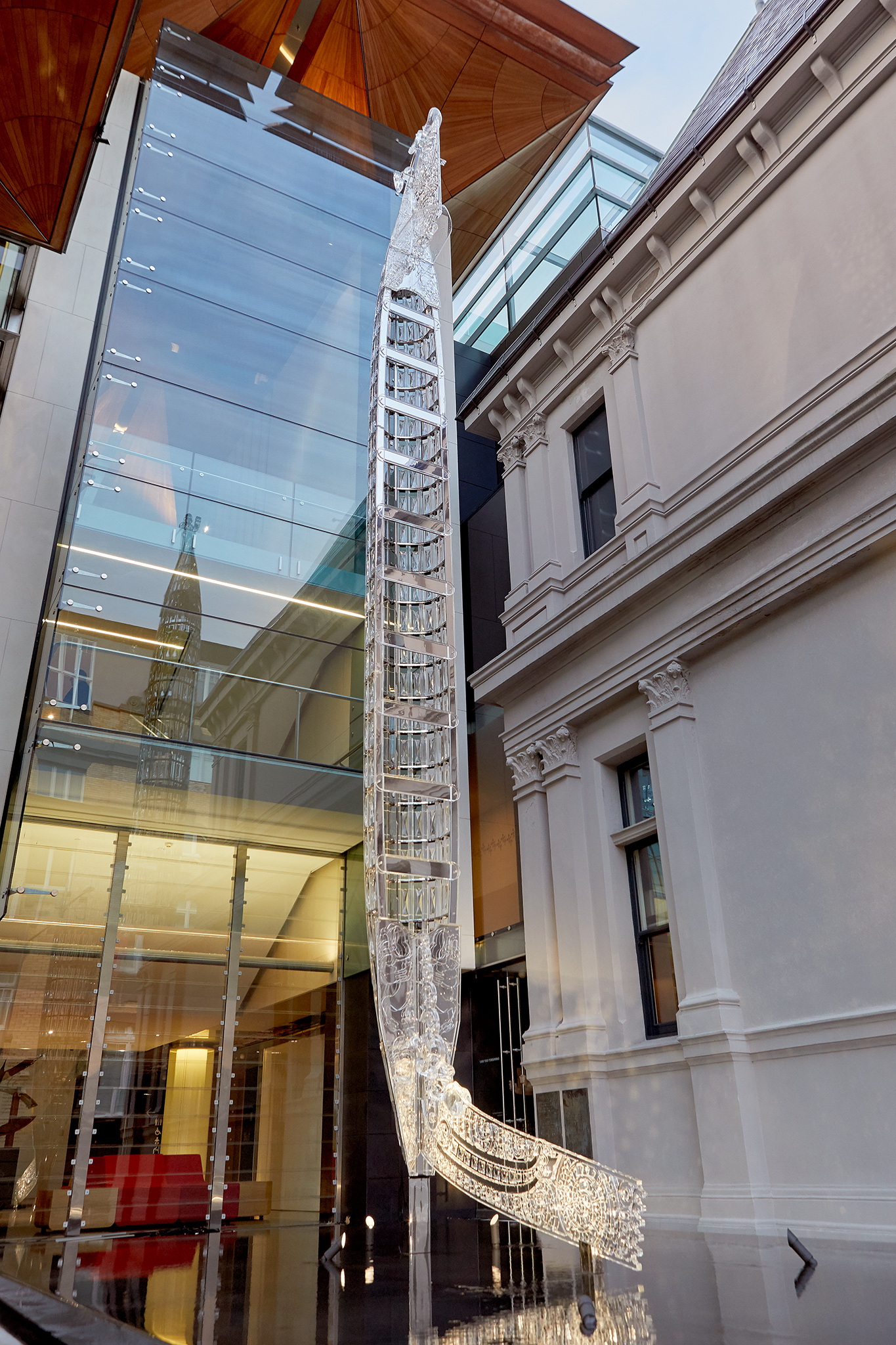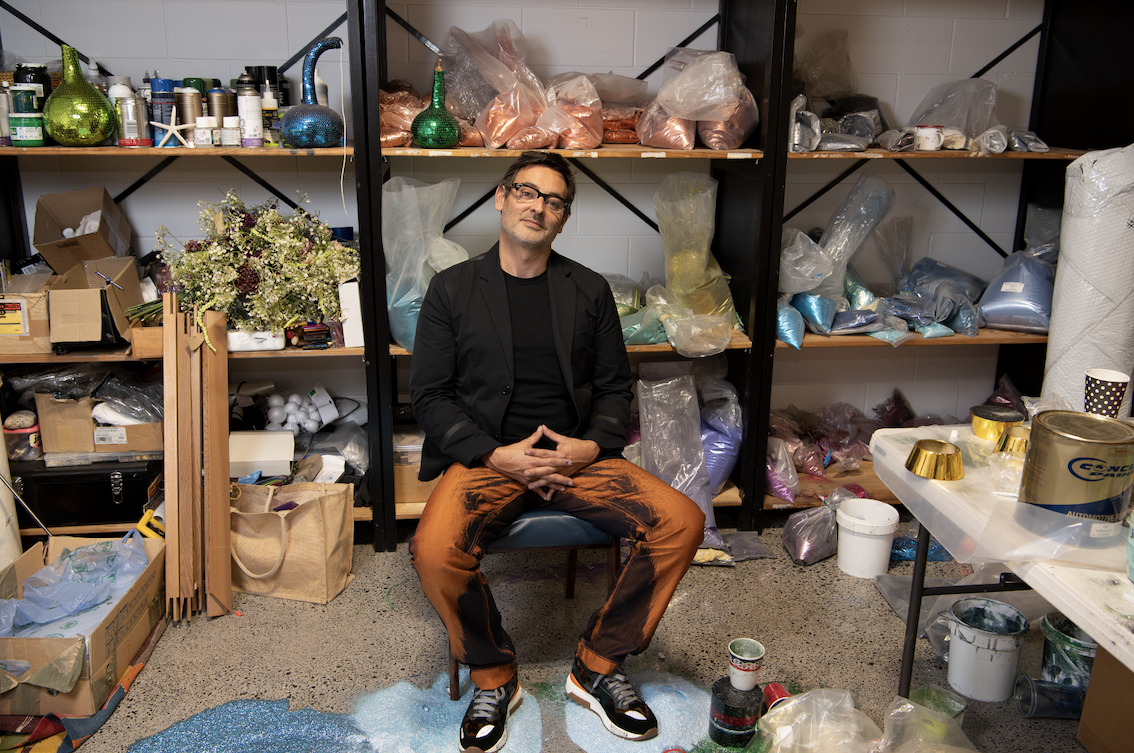One hundred and thirty-five years ago, the ghostly apparition of a waka taua, war canoe, was sighted across Lake Tarawera. This waka wairua, spirit waka, was observed by a local kaiārahi Te Paea Hinerangi, known as Guide Sophia, as she led a whaleboat of tourists on an excursion to visit the world-famous Pink and White Terraces. While eyewitness accounts vary, Māori and Pākehā onboard the boat tell of a mysterious waka appearing in the distance before vanishing again. Local high priest Tūhoto Ariki of Tūhourangi reportedly interpreted the waka wairua’s manifestation as ominous. [1] His concern was well-founded: 11 days later, on 10 June 1886, Mount Tarawera violently erupted, completely destroying the Terraces and three nearby villages.

Reuben Paterson, Guide Kaiārahi, 2021, stainless steel, transparent acrylic and glass, commissioned by Auckland Art Gallery Toi o Tāmaki, owned and generously supported by the Edmiston Trust. Photo: Hamish Melville
Now, another ghostly apparition has appeared: a 10-metre waka pītau, carved war canoe, made of transparent material, levitates above Auckland Art Gallery Toi o Tāmaki’s forecourt pool. The sculpture by artist Reuben Paterson, commissioned by the Gallery and generously supported by the P A Edmiston Trust, invites visitors on a speculative journey through time and space to consider worlds beyond our own. Paterson, who has Te Arawa, Ngāti Rangitihi, Tūhourangi and Scottish ancestry, grew up with stories of the phantom waka and has long been fascinated by the mysterious circumstances around its appearance. After the fateful eruption, Paterson’s Ngāti Rangitihi hapū settled in Matatā and his whānau still live in the area.
Paterson has named his sculpture Guide Kaiārahi and intends it to operate as ‘a guide, a leader and an escort’. [2] ‘We are being guided into unknown and unmapped territories,’ he says, ‘that are often the hidden cultural knowing I have come to appreciate as they rise to the surface as truths. These ideas are the inspirations behind this work, and the logic systems used to define and determine the answers to esoteric phenomena.’ [3]
There are many theories explaining the miraculous presence of Lake Tarawera’s phantom waka. ‘To Māori in the village and on the lake,’ Paterson explains, ‘the occurrence had only one meaning. It was an omen of inevitable disaster, coupled with a typhoid outbreak two weeks before and unpredictable thermal activity that was creating sudden surges along the shorelines.’ [4] Some believe that the atua or god Te Tamahoi, long buried in Mount Tarawera by Ngātoroirangi, was expressing his pent-up rage that the tapu of the area was not being properly observed.
In 1886 G M Park wrote a letter to the editor of Wairarapa Daily Times arguing that the phantom waka could have been caused by a mirage: ‘an unequal refraction of the lower strata of the atmosphere over Lake Tarawera on the day ... would cause the canoe of the tourists to be reflected in a fantastic form, thus giving the mirage the appearance of a large war canoe.’ [5] Others have speculated that phantom waka was a different naturally occurring optical phenomenon known as a ‘Brocken spectre’, which results in a magnified shadow of an object appearing in certain atmospheric conditions.
Paterson concludes: ‘Both scientific explanations look at the bending and invisibility of light as the portal through which visions can appear, alongside a more esoteric reading of the waka as a spiritual apparition. Here two worlds exist in explaining the miraculous, timed to an important and spectacular tragedy within our history, forever marked by tales of the unknown.’ [6]
Paterson is clear that Guide Kaiārahi is a sculpture, not an actual waka. It has another destiny. The title is, in part, an acknowledgment of Te Paea Hinerangi, but the artist also intends the sculpture itself to be our guide on our own journey. Where is ‘he’ taking us? Does the work foretell some cataclysmic event? Or does it act on us as a kind of navigational tool – a star compass, a metaphorical ladder, or the hands of times – where our encounters with it, and with the future, are shaped by our own knowledge base, our desire to learn and our willingness to enter into uncharted territories. Will it lead us to a place of enlightenment, or will we fall crashing back to earth? Paterson has intentionally created a public artwork that will stop us in our tracks, spark our curiosity and let our imaginations take flight.
The reflection pool on Auckland Art Gallery’s forecourt is a symbolic reminder of the waters that run beneath the ground near the Gallery: Horotiu stream which courses beneath Queen Street and Te Wai Ariki, a spring located in nearby Waterloo Quadrant. Instead of levitating horizontally above the pool, as we might have expected, Paterson’s work is pivoted onto a virtual axis, transforming the Gallery’s glass stairwell into the waka’s open water. As we ascend the stairs, we follow its journey, skyward, heaven bound. I like to imagine we are onboard a ‘star waka’ – as Robert Sullivan writes in his poem, ‘Waka 46’:
a space waka
rocketing to another orb
singing waiata to the spheres [7]
[1] ‘1886: The Tarawera Eruption’, Ngati Rangitihi website, https://ngatirangitihi.iwi.nz/about-us/history, accessed 23 May 2021.
[2] Reuben Paterson, unpublished artist statement, 2020.
[3] Paterson, unpublished artist statement, 2020.
[4] Paterson, unpublished artist statement, 2020.
[5] G.M. Park, ‘Letter to the Editor’, Wairarapa Daily Times, vol. VIII, issue 2339, 6 July 1886, p.2. https://paperspast.natlib.govt.nz/newspapers/WDT18860706.2.9?items_per_page=10&query=mirage+phantom&snippet=true&title=WDT, accessed 6 June 2021.
[6] Paterson, unpublished artist statement, 2020.
[7] Robert Sullivan, ‘Waka 46’, Star Waka, Auckland: Auckland University Press, 1999, p.50.
Image credit: Reuben Paterson in his studio. Photo: Jennifer French
